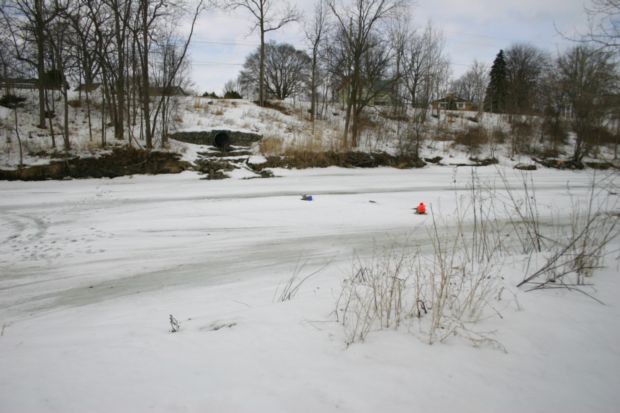The two local conservation authorities are saying the short-term forecast does not indicate any flooding on the Thames or Sydenham Rivers.
However, this could change as the weeks go on.
Girish Sankar, water resources engineer with the St. Clair Region Conservation Authority said the Sydenham River has ice in it, 14 to 16 inches thick.
“The Sydenham River is very stable,” he said. “There is considerable ice conditions right in the East branch from Wallaceburg to Dresden, just upstream to Dresden even, and along the North branch right from Wallaceburg to Wilkesport, just north of our McKeough dam. The conditions appear to be very stable.”
Sankar said the short-term forecast does not indicate any threat for flooding.
“With the melt that we are set to experience today and tomorrow, with a seven degree high today and five degrees tomorrow, this is the kind of the weather we like to see to avoid flooding conditions,” he said. “With the night time lows below freezing. So there is going to be some snow melt but it is not going to be significant to increase the water levels in the river.”
Sankar these type of conditions is what they were hoping for.
“This watershed had all the ingredients for a major flooding event, referring to the snowpack that is in the watershed, we had roughly about two-feet of snow and the ice conditions as well, but having what we’re referring to as “maple syrup-type weather”, where the day time highs are about seven or eight and the night time highs are below freezing. It just melts a little bit, but it’s not enough to raise the water levels to create any issue,” he said.
Sankar said the conditions for snowmobiling are safe, but maybe not ideal.
“Safety is something we emphasize,” he said. “Especially when you have temperatures at seven or eight degrees, there is a chance that the top couple of inches in the river could be under water and the ice will be underneath that. It could be slushy conditions. In terms of stability, yes you could walk on it, you could have a snowmobile on it, but there will be water on top of the ice, which may be not be ideal for snowmobiling. But it will be stable and safe.”
Jason Wintermute, water management supervisor with the Lower Thames Valley Conservation Authority, said there is currently 12-inches of ice along the Thames River.
“We may lose a little bit over the next few days because of the warm-up but probably not too much,” he said. “12-inches is a depth where we have historically had ice jams, which is why there is talk of this kind of stuff now. In terms of immediate, we need flows in the river as well as the proper thickness of ice to create an ice jam. The weather forecast for the next week or so are not indicating any substantial rain or significant melt. It is suppose to get up to 9 degrees Celsius but only for one day and it’s dipping back down again. So we’re not looking at significant melt or significant rain over the short term forecast that would indicate that the flows would rise enough to break up the ice on the river and cause jams.”
Wintermute said in the short term there really isn’t anything to indicate flooding in the next week.
“As we start pushing into the end of March the forecast are not as good,” he said. “We could get those large rains, significant melts which causes and creates the ice jams.”
Wintermute said these warnings are coming out to ensure people are prepared.
“If you’re living in those flood prone areas you should be thinking about this,” he said. “Even in 2011, we didn’t have this much ice and we still had ice jamming. We havne’t seen this much ice in quite a few years. We’re hoping people take some time to think about it, what kind of precautions they may take.”
He added everyone is hoping for a slow melt across the region.
“I think we all hope for a nice slow melt that will slowly degrade the river ice, but if we get a sudden melt or a couple inches of rain with a sudden warm up that could generate the flows that could create ice jams. With the weather we’ve had the past couple of years, big rainfalls are not uncommon.”
Wintermute added: “In terms of being concerned or not concerned… it’s really a ‘watch the weather kind of thing’… that’s going to decide whether we have flooding or not.”

















